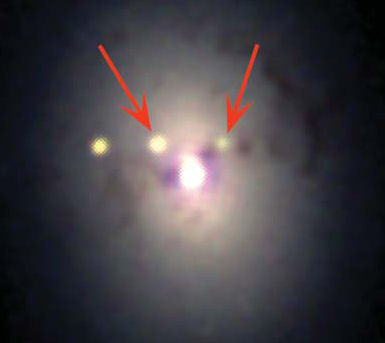Talk about an explosive personality. Large galaxies usually have no more than three supernovas blow up in a century, but the nearby galaxy NGC 1316 has had two such explosions within the past 5 months and four in the past 26 years.

Amateur astronomer Berto Monard of Pretoria, South Africa, found both of the new supernovas. He reported the latest find in a Nov. 6 electronic telegram of the International Astronomical Union. After that announcement, Stefan Immler of NASA’s Goddard Space Flight Center in Greenbelt, Md., and his colleagues used NASA’s Swift satellite to view the two most recent stellar explosions. They unveiled their image Nov. 20. The team confirmed that like the earlier two NGC 1316 supernovas, the most recent ones belong to the class called type 1a.
While some researchers are puzzling over the supernova surplus, others propose a simple explanation. Supernovas of type 1a arise after a star that’s less than eight times the mass of the sun becomes a compact star called a white dwarf. If the dwarf siphons enough mass from a companion star, the accumulated material triggers a thermonuclear explosion, blowing the dwarf to bits. Astronomers have used type 1a supernovas to infer the presence of dark energy, a mysterious substance that has revved up the rate of expansion of the universe (SN: 11/18/06, p. 323: Available to subscribers at Dark Fingerprints: Hubble sheds light on cosmic expansion).
Hubble Space Telescope images have shown that NGC 1316, an elliptical galaxy lying 80 million light-years from Earth, has swallowed spiral galaxies, smashing together gas clouds and generating new massive stars. Several such mergers happened about 3 billion years ago, and there was a less powerful one a few hundred million years ago.
“Clearly, the high supernova-production rate must be related to this recent merger of the two galaxies,” notes Immler. Other astronomers agree.
However, Immler says, there’s a mystery because many stars take several billion years to become white dwarfs and then explode as type 1a supernovas.
Astrophysicist Mark Sullivan of the University of Toronto counters that recent studies by his team and others have shown that some type 1a supernovas take less than half a billion years to form. He suggests that a galactic collision could create massive stars, which take a shorter time than less-massive stars to become white dwarfs, hastening their explosion as 1a supernovas.
A collision of galaxies might also create shock waves that speed the rate at which white dwarfs steal material from a companion, suggests Mario Livio of the Space Telescope Science Institute in Baltimore.
After learning about the new supernovas, Immler encouraged researchers to reexamine other elliptical galaxies that have undergone recent mergers. Those scientists found a surplus of type 1a supernovas too.
“We are trying to figure out what is going on,” Immler says.







